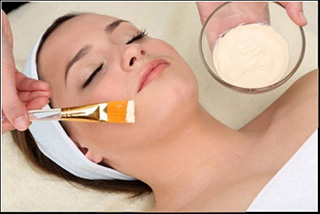Skin Peels – the Glycolic Acid Vs. Lactic Acid Debate
By Lisa Young – Salon Director
Skin Peels are becoming one of the most frequently requested services in many salons and skin Centres. This form of chemical exfoliation offers instant results yet is still affordable when compared to laser and other types of treatments.
Skin Peels or Chemical Peels as they are also referred to, work to:
- Stimulate collagen.
- Reduce pigmentation.
- Even out skin tone.
- Rejuvenate, brighten & freshen your skin.
- Reduce fine lines.
- Reduce acne scarring.
- Create a radiance to the skin.
Many clients think that a skin peel means excessive redness and skin “peeling” and that they will need a few weeks off to hide away whilst the skin repairs itself and the redness subsides.
This is so untrue of today’s generation of Skin Peels. Yes, there are still some extreme skin peels available but with the majority of Skin Peels available today you are able to resume your normal daily activities immediately after the treatment.
Chemical exfoliation or skin peel treatments typically use Glycolic Acid or Lactic Acid, which are Alpha Hydroxy Acids (AHAs).
The common misconception regarding Skin Peels is that Clients equate the level of irritation to the level of effectiveness of the treatment.
Based on this common misconception, Glycolic Acid has always traditionally been favoured as the skin peel of choice. This is because it can create more irritation. The client therefore tends to believe this means that its “working better” and that they will therefore get better results! Unfortunately, this is so untrue and pain does not mean gain in this case. Inflammation can very have a negative effect on the skin causing premature skin ageing!
Let me explain why Glycolic Acid Peels aren’t necessarily the best choice but first I’ll help you understand the effect on the skin during and after the healing period for both these Alpha Hydroxy Acids (AHAs) and how they work on the skin.
Ultimately, AHAs should accomplish a few main, immediate goals with minimal or zero inflammation therefore reducing the risk of pre-mature aging. AHAs should stimulate the desquamation process i.e. the natural process of exfoliation or sloughing off dead skins cells. This has the same effect as achieved by microdermabrasion.
Desquamation or exfoliation triggers cell renewal. As it does this it plumps out fine lines and wrinkles, even out skin tone and reduces pigmentation.
Glycolic Acid and Lactic Acid are both alpha hydroxy acids (AHAs). Whilst Glycolic Acid was commonly thought of as the better of the two and favoured more over lactic acid this belief is now changing.
Independent research studies on alpha hydroxy acids have determined that Lactic Acid is in fact the superior AHA.
Studies on these two alpha hydroxy acids (AHAs) have indicated that:
- Lactic Acid on a molecular level is a smaller molecule than Glycolic Acid. This means it is able to penetrate the skin far more easily than Glycolic Acid. This makes it less irritating to the skin than Glycolic Acid
- The activity of Glycolic Acid and Lactic Acid in water-based formulas is controlled by the pH of the solution. Optimum activity is at pH 3.0-3.2 and lowering the pH below this level only causes more irritation. Scientific studies have demonstrated that Lactic Acid stimulates cell turnover and cell renewal at a higher rate than Glycolic Acid and with less irritation.
- Lactic Acid has more added benefits than Glycolic Acid in that it:
- Hydrates the skin.
- Increases the skin’s epidermis barrier lipids (natural ceramides).
At Studio 8 Beauty we use Dermalogica BioSurface Peel which uses a bi phase approach skin peel which includes both an enzyme and acid level. BioSurface Peel is a lactic acid based skin peel and you receive a complimentary aftercare pack to ensure you have everything you need to care for your skin. The results can be enhanced further with electrical modalities. To find out more details please read about our Dermalogica BioSurface Peel.
What to expect from a skin peel and how to get great results
- Always following pre and post treatment care.
- You should always receive a full consultation including a medical and health questionnaire as well as a visual inspection of your skin. (Dermalogica uses Face Mapping Analysis).
- Be truthful during the consultation and ensure that you declare and discuss all medication, skincare products and health concerns as this may indicate contraindications to the treatment, where extra post care guidance is required or any factors that may affect results.
- Chemical treatments stimulate the skin, so expect some level of mild redness. Your skin should never appear completely red or irritated,
- Your therapist should communicate with you throughout the treatment to understand what sensations you are experiencing and any level of irritation. Skin peels are not the right treatment for idle chit chat and to ensure your safety the therapist needs to ensure that they understand how your skin is feeling. Skin health and your comfort is the number one priority.
- Remember irritation isn’t always visible immediately. Don’t be afraid to speak up if something does not feel right at any point during the service.
- Under no circumstances should never be left alone during your treatment.
- Make sure you understand the aftercare and you receive this written down so you can refer back to it.
- Follow the aftercare to the letter to ensure optimum skin health benefits and results.
So there you have it. Everything you need to expel the myths about Skin Peels.
If you would like to know more about skin peels please contact the salon on 023 92 380 792 to arrange a consultation with one of our Skincare Experts.
Quote of the Day
“Life is like an onion. You peel it off one layer at a time, and sometimes you weep”
Rita Mae Brown
